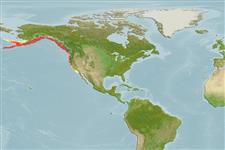Teleostei (teleosts) >
Perciformes/Scorpaenoidei (Scorpionfishes) >
Sebastidae (Rockfishes, rockcods and thornyheads) > Sebastinae
Etymology: Sebastes: Greek, sebastes = august, venerable (Ref. 45335).
Eponymy: John Pease Babcock (1855–1936) was a fisheries expert, civil servant, conservationist and author, who helped to establish the scientific and institutional underpinnings of fisheries conservation in British Columbia although he had no formal [...] (Ref. 128868), visit book page.
Environment: milieu / climate zone / depth range / distribution range
Ecology
Marine; demersal; depth range 49 - 625 m (Ref. 6793). Temperate; 66°N - 32°N, 179°W - 116°W
North Pacific: Zhemchug Canyon in the Bering Sea and Amchitka Island in the Aleutian chain to San Diego, California, USA.
Length at first maturity / Size / Weight / Age
Maturity: Lm 38.5, range 34 - ? cm
Max length : 64.0 cm TL male/unsexed; (Ref. 2850); max. published weight: 4.4 kg (Ref. 40637); max. reported age: 106 years (Ref. 39247)
Dorsal spines (total): 13; Dorsal soft rays (total): 13 - 15; Anal spines: 3; Anal soft rays: 6 - 7. Head spines strong to moderate - nasal, preocular, supraocular, postocular, tympanic (may be absent), coronal and parietal spines present, nuchals usually absent (Ref. 27437). 2nd anal fin spine longer than 3rd (Ref. 27436). Posterior margin of caudal fin almost straight (Ref. 6885). Light pink to red with 4 darker red vertical bars on body (the first extending from front of dorsal to the base of pectoral, the last found on the caudal peduncle), the bars more prominent on smaller fish; 1 dark bar radiating from each eye (Ref. 27436).
Found on soft bottoms (Ref. 2850). Viviparous (Ref. 34817).
Eschmeyer, W.N., E.S. Herald and H. Hammann, 1983. A field guide to Pacific coast fishes of North America. Boston (MA, USA): Houghton Mifflin Company. xii+336 p. (Ref. 2850)
IUCN Red List Status (Ref. 130435: Version 2024-1)
Threat to humans
Harmless
Human uses
Fisheries: minor commercial
Tools
Special reports
Download XML
Internet sources
Estimates based on models
Preferred temperature (Ref.
123201): 3.7 - 7.1, mean 5.5 °C (based on 149 cells).
Phylogenetic diversity index (Ref.
82804): PD
50 = 0.5000 [Uniqueness, from 0.5 = low to 2.0 = high].
Bayesian length-weight: a=0.01000 (0.00495 - 0.02022), b=3.09 (2.92 - 3.26), in cm total length, based on LWR estimates for this Genus-body shape (Ref.
93245).
Trophic level (Ref.
69278): 3.8 ±0.5 se; based on size and trophs of closest relatives
Resilience (Ref.
120179): Very Low, minimum population doubling time more than 14 years (tmax=106).
Fishing Vulnerability (Ref.
59153): Moderate to high vulnerability (46 of 100).
